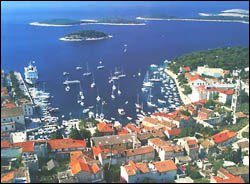
Statistics will hardly tell you anything about the Hvar island villages and the isolated places enlivened by the local people and tourists who wish to get closer to nature. While separation from the mainland can sometimes be a handicap, it also provides some protection from the factory chimneys and other misfortunes which come with civilisation. Instead, there are vast fields of lavender, ancient olive trees and vineyards, in immaculate harmony between man and nature. There are wine and olives, so a guest wishing to get closer to nature will stop at a small inn rather than a top quality restaurant. He will taste real home-made wine instead of some famous sparkling wine, he will sing the old island songs and forget the monotony of the everyday routine. Through the centuries and life's sufferings, an oasis of culture has remained here, a testimony to the identity, despite the many attempts, some temporarily successful, to destroy it.
Every guest is really The Guest here and his every wish is a command. Hard-working hosts are well aware of this. They will offer home-made bread and smoked ham or freshly picked mandarins or fish garnished with home-pressed olive oil. Without additives or preservatives but with that natural taste that you sense when you feel a togetherness with unspoiled nature during your visit to the island.